Impact Mapping in practice
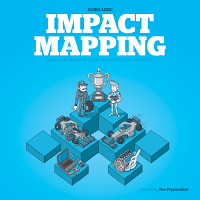
When I read the book Impact Mapping for the first time, I had the desire to throw it in the middle. Everything written there is too obvious. I found the strength and read it, the benefit of the book is short and with large pictures. As it turned out later, the whole point was that I did not apply all these obvious and simple practices from the book in my work.
Sometimes customers wrote their goals in official documents to the project. Sometimes it seemed to me that I already understand the goals of the customer - they are absolutely obvious. Why clarify the obvious? I felt the difference when I started using Impact Mapping at work.
')
Impact mapping history
Previously, at the start of the project we had technical tasks, system operation schemes and, in a good version, interface prototypes. These documents lacked an understanding of the project’s development dynamics and work priorities.
We started writing User Story and doing Story Mapping . These practices have added an understanding of how the project will develop, what are the priorities, gave us the opportunity to communicate more productively with the customer. What was missing? Products do not exist in a vacuum, you need to see more global tasks that lie somewhere above the histories of using the system. There was a lack of simple gaming practice for setting the goals of the project, from which then Story Mapping and the User Story list will appear.
In 2007, Mijo Balic and Ingrid Ottersten wrote an article, Effect Managing IT (more on Agile product management using Effect Maps ). After 4 years in 2011, Gojko Adzic published the book Specification by Example , where in the chapter “Deriving scope from goals” he mentions a technique called Effect mapping. This technique is designed to help teams focus on business goals, identify stakeholders and their needs .
Over time, Gojko Adzic adds several improvements to the Effect mapping, such as: prioritization of goals and impacts, the ability to move away from technical details at the What level, cyclicity in assumptions and experiments, etc. Personally, it seems to me that these are important changes, they add utility in real life. After this, the technique began to be called in a new way - Impact Mapping.
How much is a kilo of code?
Imagine the situation. A customer comes to you. He already has a set of features to buy, he knows what he wants. He takes the shopping cart as in a store. Add to it a list of technologies, a dozen interface prototypes, integration with social services. networks, etc. He comes to the checkout and asks to weigh everything, to implement and invoice him.

It turns out that the customer came to you with ready-made solutions to some of their problems. In such a situation, only the developer’s hands will be at work, but not the head. The developer will not be able to critically look at all the decisions that we will make.
Will such a project be successful? If the client has a live business and the project is not done “on the table”, then success can only be assessed by the effect that was exerted on the business. Not the number of features set, not meeting deadlines, not respecting the budget, but only changes in the business.
Frankly, it is difficult to ensure that the project will be successful. But in our power to increase the chances of success due to the fact that everyone in the team will understand and share the goals of the business. Then any decision - from naming a variable in code to choosing an architecture - will be made based on the real needs of the business.
The question remains, how to pull out the real business goals from the customer that we want to achieve? How to make the team hear them, accept and start working with them?
We make Impact Mapping
Impact Mapping is a mind map for project goals with an influence map that should push the customer's business to achieve goals.
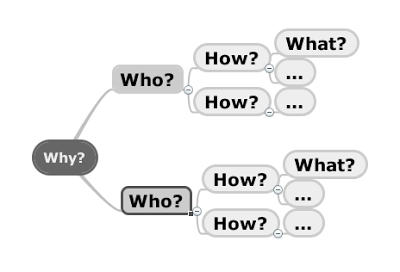
Why?
The central element of our map, which answers the key question: Why are we doing this? This is the goal that the business is trying to achieve.
Who?
At the first level, we answer the questions: Who can help achieve the desired result? Who can interfere? Who are the users of our product? This will include all interested parties that may affect business goals.
How?
At the second level, we must describe the impacts that interested parties must have in order for the business to achieve its goals. We are looking for the answer to the questions: How will they help a business achieve its goals? How can they hinder the success of the project?
What
After answering basic questions, you can discuss specific tasks. The third level answers the questions: What can we do as an organization or development team to create the necessary impacts? The final result of our work will be described here.
Organization of the process
- Invite no more than 10-15 people to this event, otherwise it will be difficult to hold. It is optimal to call 3-4 people from the customer and the same from the team.
- From the customer’s side, it is imperative to take representatives of the business, and not just technical specialists, who already have an opinion about the specific implementation of all the goals.
- The map will be built on a blackboard or wall, prepare them in advance. Impact mapping for a task with a duration of 6-8 months fits on a standard size board.
I have not tried the online version of this technique yet, but I think any interactive tool will do. Communication will not be the same, but you can be saved if you personally know the customer or are an excellent facilitator / moderator. - Preparation of the card will take from one hour to two days. This figure is highly dependent on the membership and your skills.
- Each block of the map can be drawn with a marker or made with stickers. I prefer the stickers, because they are more mobile, and the impact map will often be sorted and changed in the course of immersion in the project.
- Before you begin, be sure to say the rules and goals of the map. If you have time, then send out all the material on the subject to prepare
- If possible, and circumstances allow, make a few Icebreakers.
- And most importantly - the process itself should be easy and fun. Do not add bureaucracy to it!
Practical example
Let us analyze an example that is very close to the real project, for which at the beginning we did Impact Mapping. Let us dwell on the key points in the compilation of Impact Mapping and on errors that can destroy the whole idea.
Why?
The root element of our map will be a list of business goals. For example, this may be an increase in user satisfaction by 2 times . It is important that user satisfaction is an index, i.e. a specific figure that can be taken from CRM, and not the opinion / feeling of the customer. After the delivery of features, we want to measure the achievement of the goal and understand whether we are going in that direction or not. If user satisfaction was not a figure, how would we know that we had reached the goal? It is also important that we wrote exactly 2 times , and not just an increase . Good goals should be SMART :
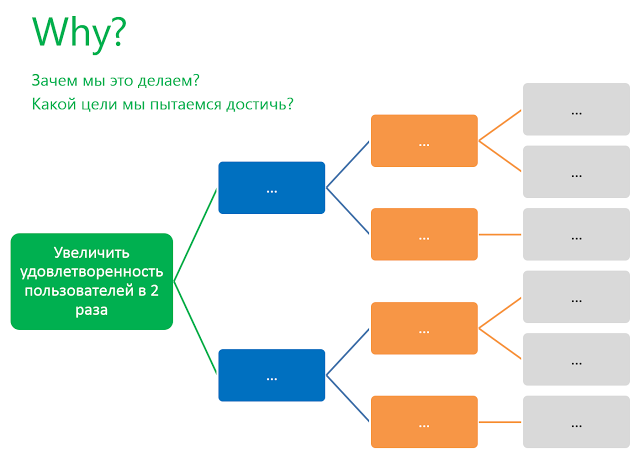
The first stage is quite difficult, it should give impetus for the preparation of the rest of the map and create trust between the participants. What can I advise, based on my practice:
- Do not rush to offer solutions at this stage. Listen to the customer, really listen. In the course of further discussion, you will have time to adjust everything and brush your hair, but for now write down what is in his head.
- The most common problem is to impose solutions (What? Stage) before the goals become clear. Engineering thought flies with the speed of light - the customer only opened his mouth, just started talking about his goals, and we have already created a database with all the tables, invented architecture and threw pieces of code. Why listen further, if we have already thought of everything? It will be a mistake to begin to interrupt the customer and propose solutions. Remember the anecdote on this topic and try to avoid the problem: “Dima said“ Hello ”, and Dasha mentally played the wedding and gave birth to three children.”
- Do not overtake the order at this stage. At the very beginning, you do not know his business in all its subtleties. Customers can trust you as IT professionals, and because of this, quickly agree to your adjustments. You yourself will not notice how only those goals that you have imposed, and not those with which the customer has lived all this time, will be on the board.
- Even if the goal is hard to measure, then try to come up with a criterion for its achievement. Mentally transfer to the final of the project and think about how you will know if the goal has been achieved or not?
- The process of setting goals is iterative, it is not necessary to squeeze out all the goals from the customer in the first round.
- No need to pull artificial targets. There are projects that just exist, because investors want to play software creators. With this you need to accept and minimize the work on the compilation of Impact Mapping.
At HappyDev 2014, I conducted a master class on compiling Impact Mapping and Story Mapping. Play the role of the customer agreed to the project manager for processing applications for construction. All those who came to the training were very active and immediately became involved in the process. Over time, we realized that it’s quite difficult to just listen to a customer and understand his problem. Colleagues vying offered their solutions. At some point, we had to interrupt the work of the group, remind us that we should listen more. Several times because of the tense atmosphere and the pressure of the participants, the customer made our decisions, withdrawing from his own. I think that all participants felt an important balance between when to listen to a customer and when to offer solutions.
Who?
At this stage, we must identify all those who help to influence the goal, who will contribute to its achievement or hinder. In our example, this will be the Marketing Department and the Forum Moderator . According to the customer, it is they who can change user satisfaction:
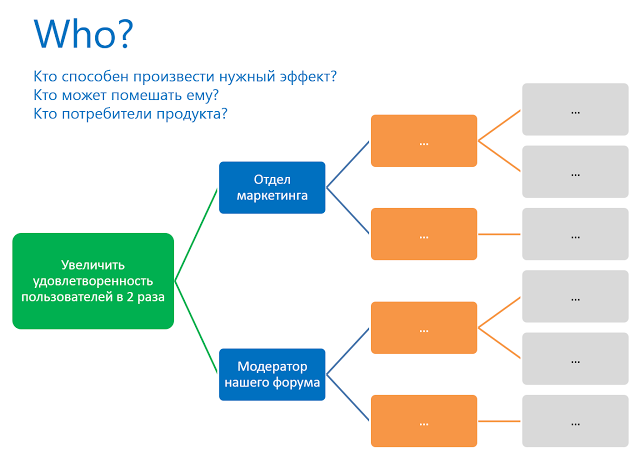
Here we can indicate specific people, department names, market segments, etc. Choose any level of abstraction, as long as it is adequate to your project.
How?
Now we need to determine the impacts that will be made to achieve the goal. For example, a forum moderator may try to answer questions for 1 minute. Do you think this will increase user satisfaction? We have an assumption that will increase, so we write down this “impact”. Do the same for the rest of the roles:
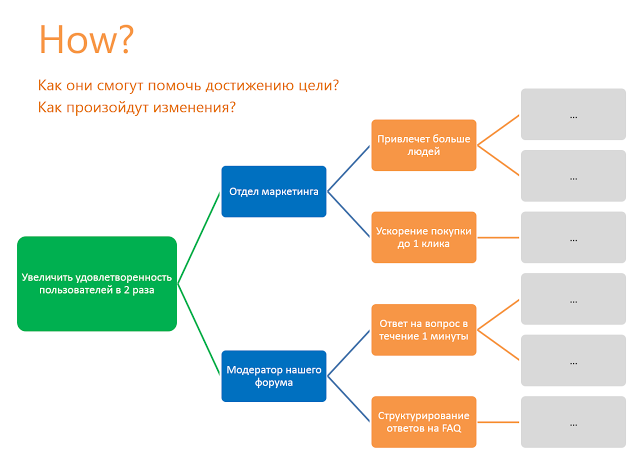
A few recommendations:
- Optionally, but it is desirable that the effects also be measurable. We have written not just Answer on the forum , but Answer on the forum within 1 minute .
- Do not record all the possible impacts of each role. We need only those activities that lead to the achievement of the goal.
What
We have reached the most unimportant in Impact Mapping. In the last node of our map is the same shopping basket, which usually begins work on the project. The difference is that now we understand the value of each feature, why this feature is here and what its implementation will lead to:

A few comments and recommendations:
- At the end nodes of the map, you can write User Story or the names of modules / subsystems.
- You can not paint this part of the map, you can not even fill it at all, but just speak its main points. A complete list of all User Story you have time to create on the Story Mappging'e.
- It is not necessary to describe IT-tasks here. Instead, you can write some organizational changes and, in general, any actions to implement the impact on the target.
- Understanding goals gives us the opportunity to create cheaper and faster solutions to achieve these goals. Due to the map, we are starting to use not only the hands of the developers, but also the head - each team member can make informed decisions.
Impact Mapping Results
Here is our Impact Mapping. It remains to prioritize each column. Not all goals are equally important, the same can be said about the other nodes of the map. There are different ways to prioritize. Since we follow the path of simplicity and visualization, then I can recommend to put asterisks. Each participant is given 5 stars and he can put them where he wants. Thus, it is possible to identify the highest priority nodes.
The result of the work must be hung in plain sight. If the team is distributed, then you need to lay out Impact Mapping in the general knowledge base or hang up in front of the screen, which all development participants see. The main goal is to ensure the visibility and accessibility of this information, because we rely on it when working on a project.
When I talked about Impact Mapping at AgileClub , my colleagues noticed that there are other ways to understand strategic goals. For example, you can use Lean Canvas or collect the requirements in the project documentation with a description of the objectives and stakeholders. In fact, Impact Mapping does not contradict other approaches and can be used with them. Personally, I like it more because:
- This is a simple technique that promotes communication and interaction, there is no bureaucracy.
- For customers who do not understand IT and software production, this approach is very simple to explain, just a couple of minutes are enough.
- Mind map visualization
Incoming task filter

Even when everyone agrees with the project’s goals and ways to achieve them, the customer can add to the project a feature that he really likes - the pet feature. We can filter it through the goals, show that this feature will in no way lead us to achieve the goals.
Similarly, we will filter ideas for architecture and system design that come from the development team. Does reworking the architecture lead to faster and cheaper goal achievement? If not, why do we need to do this?
Modernization Kanban-boards
What is the last column on your Kanban board? I bet it's Release, Deploy, Done, or something like that. The last column on the board should be - check the achievement of the goal. It is not enough just to upload the feature to the server, we need to check whether we have reached the goal, as we assumed or not.
FAQ
- How to sell the creation of Impact Mapping to the customer before starting the project?
Best to go from the problem. Ask the customer to remember cases when many features have been done, and the business has only suffered from this. Why did it happen? May need to explicitly describe the goal? - Should this job be paid?
Yes, sure. Making Impact Mapping can take several days and carries business value, I do not recommend doing it for free. - What if the customer doesn't want to do this?
You, as a professional, must provide the customer with a forecast for the future. Tell us about possible problems, describe the risks and their dangers. After that, let the customer choose. If you brought a possible problem future and the client accepted it, refused Impact Mapping with full clarity of consequences, now this is not your problem, just make it a feature.
Impact Mapping is one of the activities that will make both customers and developers more happy and efficient. Set the correct goals correctly!
References:
How to get the most out of impact mapping , Gojko Adzic
How I Learned to Stop Worrying and Love Flexible Scope , Gojko Adzic
Impact Mapping - how can a dev team stop doing what they need and start doing what they need? , Dmitry Petrashev
Source: https://habr.com/ru/post/246401/
All Articles